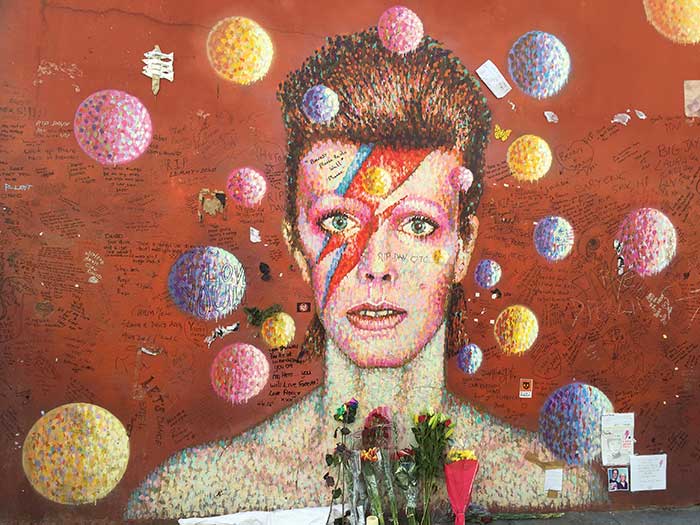Sponsored Listings:
Following his death in January 2016, tributes to David Bowie sprung up all around the world, showing that he was truly an international icon.
However, there are three cities that played a particularly important part in his life – London, Berlin and New York. Here’s our guide to the sights and neighbourhoods in these cities that shaped Bowie’s life and music.
London
Bowie street art, Brixton
South London
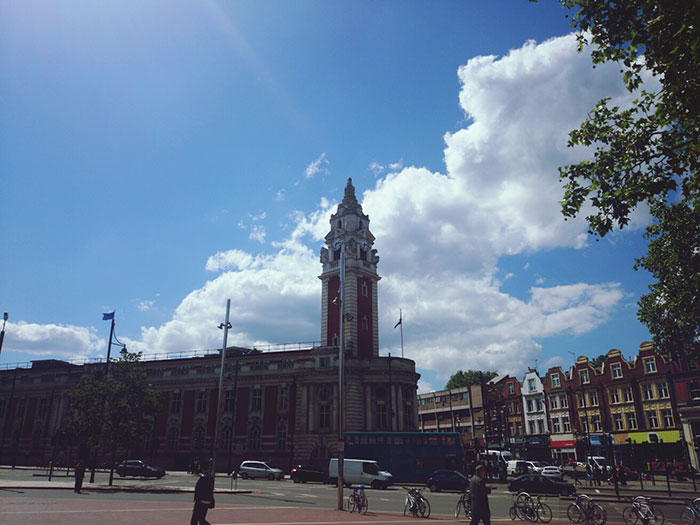
Brixton High Street
Born in Brixton on 8th January 1947, David Robert Jones spent the first six years of his life in the area, living at 40 Stansfield Road, and attending the nearby Stockwell Primary School.
His family then moved even further into the South London suburbs, to Bromley, living at first on Cannon Road, then Clarence Road and Plaistow Grove. Bowie attended Bromley Technical High School, now Ravens Wood School, and studied the saxophone with musician Ronnie Ross, at his house at 6 Irvine Way in nearby Orpington.
Although Bowie’s time in Brixton was relatively brief, the town centre was the centre of London’s tribute events to him after he died, and you can still see the mural of him at Tunstall Road, near Brixton Station.
Soho
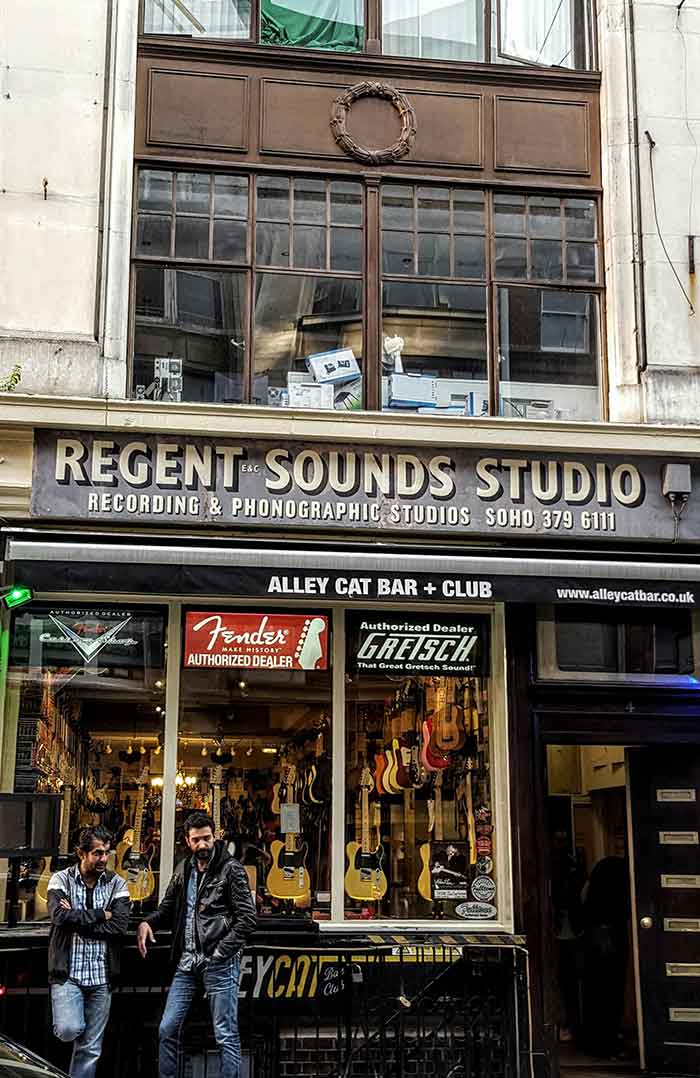
Denmark Street, Soho
While growing up in the suburbs, Bowie had his sights set on central London – and Soho in particular – which was just starting to swing. Several of his early songs focus on the London scene, which he had first hand experience of, from playing gigs in his early groups at the rock venues that were springing up around the city, and there are plenty of Bowie-related sights to explore in the area.
Denmark Street was the heart of Britain’s music industry in the 1960s, and Bowie spent much of the time when he was starting out at the Giaconda Cafe at number 9.
The Giaconda closed down in 2015, but you can still visit another of Bowie’s regular watering holes – The Ship on Wardour Street -which was one of his favourite spots to meet journalists for interviews.
Just off Regent Street, you’ll find Heddon Street, where the front cover image of the Rise and Fall of Ziggy Stardust and the Spiders from Mars was photographed – there’s a plaque on number 15 marking the exact spot.
Beckenham
Inspired by cutting-edge London venues like the Drury Lane Arts Lab, Bowie moved back to South London, and set up his own equivalent – the Beckenham Arts Lab, at the Three Tun Pub at 157 Beckenham High Street.
Initially Bowie lived in a flat at 24 Foxgrove Road, near Beckenham Junction Station, before moving to an apartment in Haddon Hall, Southend Road with his then girlfriend, Angie, who he married at Bromley Registry Office on May 19th 1970.
Both Haddon Hall and the Three Tun Pub are now gone (the latter is now home to a Zizzi restaurant, but its place in rock ‘n roll history was marked with a plaque in 2010), but you can still visit the Croydon Road Recreation Ground, where Bowie organised a festival in August 1969 – an event he commemorated in his 1970 single, Memory of a Free Festival.
Aylesbury
Hop on a train from Marylebone Station, and head about 30 miles north to Aylesbury in Buckinghamshire. The pretty market town might seem to be a long way from swinging London, but it plays a major role in some of Bowie’s key works from the period.
In 1971, Bowie played a low-key gig at the town’s Friars’ Club, debuting some of the songs off his much-anticipated album Hunky Dory.
The show went so well that he kept his backing band from the night, later renaming them the Spiders From Mars for Hunky Dory’s follow up – Ziggy Stardust and the Spiders from Mars.
The market square mentioned in the Ziggy Stardust’s opening track, Five Years, is believed to be Aylesbury’s, and the square will soon have a statue of Bowie as a tribute, after a successful fund-raising campaign from fans.
And that’s not the only link Aylesbury has to Bowie’s career – he also played the Friars Club twice on the Ziggy Stardust tour, including the opening night of the tour. For the second show, Bowie transported some of the world’s most influential rock critics to the small market town, as well as art icon Andy Warhol.
The Friars Club itself closed and reopened a number of times, but, following its 40th anniversary celebrations in 2009, it remains open for good, and still stages gigs at the town’s Waterside Theatre.
Eventim Apollo, Hammersmith
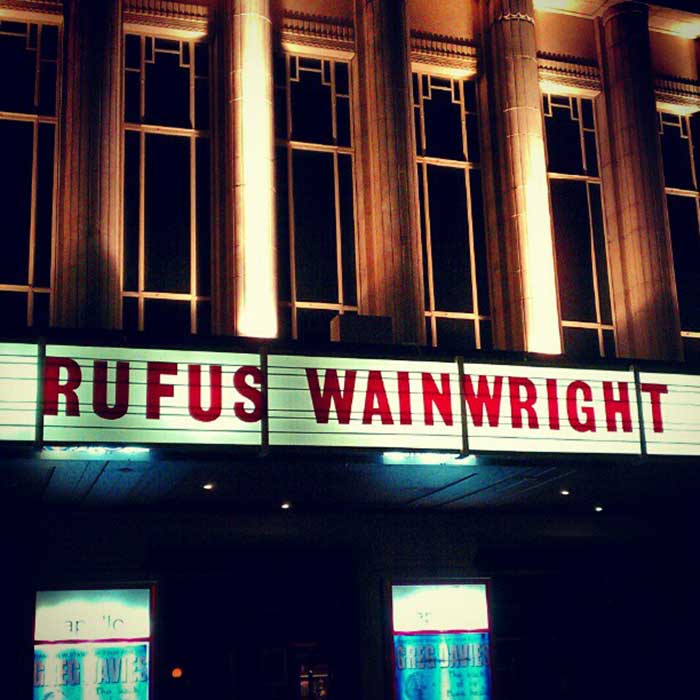
Eventim Apollo, Hammersmith
The Ziggy Stardust story came to an end in West London, at the Hammersmith Odeon. At the final date of the album’s tour – captured on film as Ziggy Stardust and the Spiders from Mars: The Motion Picture – Bowie killed off his creation, announcing to the crowd that this was the last gig that he’d ever play (needless to say, it wasn’t), before launching into Rock ‘N’ Roll Suicide.
Still one of London’s most famous concert venues, the now Eventim Apollo also hosted fellow Bromley-native Kate Bush’s record-breaking live return in 2014.
Berlin
Schöneberg
After a brief, but troubled (and drug-addled) period living in LA. Bowie moved to Berlin in 1976, along with his friend, former Stooges-frontman Iggy Pop.
Inspired by its architecture and history (as well as the famous interwar novels of writer Christopher Isherwood, who Bowie had met earlier in the decade) Bowie had a long-standing fascination with the city. He was also attracted to Berlin as it was a very cheap place to live at the time, and despite already being one of the most famous musicians in the world, it was also a place where he could live a fairly ordinary life, undisturbed by the locals.
The period Bowie spent in the city became one of the most productive in his career, inspiring not just his own “Berlin Trilogy” – the classic albums Low, Heroes and Lodger – but also Pop’s The Idiot and Lust for Life, which Bowie co-wrote and produced.
Bowie and Pop rented a flat at 155 Haupstrausse in Schöneberg. The area was, and still is, the centre of Berlin’s gay district, and Bowie was attracted to the vibrant scene.
He regularly hung out in the Anderes Ufer cafe, just a couple of doors down from the apartment. Now known as Neues Ufer, the cafe hasn’t changed too much since then – although there are now a few portraits of Bowie on its walls.
Neukölln
He might not have got its name quite right when he wrote about it on the Heroes record, but the district of Neukölln played an important part in Bowie’s stay in the city.
He first arrived in town at the district’s Tempelhof airport, and filmed scenes for Just a Gigalo in the imposing Stadtbad Neukölln on Ganghoferstrasse. Dating back to 1914, the swimming baths are still open – and just as impressive – today.
During the 1970s, the area was particularly deprived, and its housing blocks were the childhood home of Christiane F. a young drug addict whose autobiography became a sensation, later turned into a film soundtracked by and featuring Bowie.
Today, however, it’s one of Berlin’s trendiest areas, close to vibrant Kreuzberg, while the former Tempelhof airport site is now the city’s largest park, which hosts sporting events and music festivals.
Hansa Tonstudio
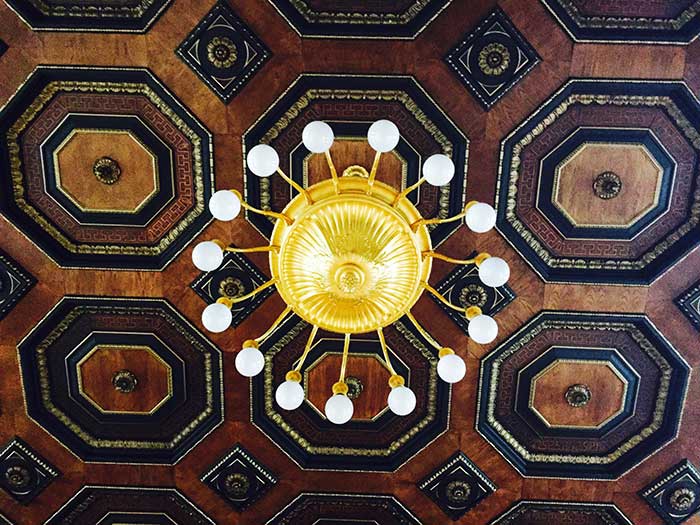
Hansa Tonstudio
Bowie, Pop and producers Tony Visconti and Brian Eno created some of their most famous works at the grand Hansa studios – including all of the Heroes and Lust for Life LPs.
Found at the edge of West Berlin, the studio’s view of the Berlin Wall inspired the lyrics to Heroes’ title track. Bowie watched Visconti’s secret rendezvous with his then-girlfriend outside the studio and transformed it into the story of two lovers who had been separated by the Wall.
Hansa studios are still in use today, and there are often tours around the complex, so you can explore the famous building and its impressive decor.
Potsdamer Platz to KaDeWe
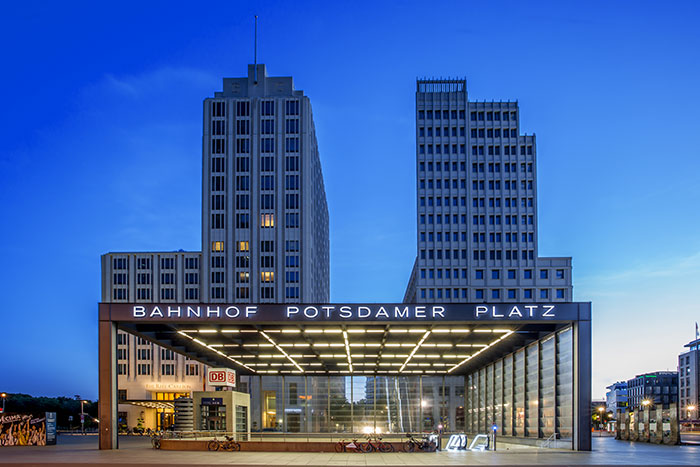
Potsdamer Platz
During the period that Bowie lived in the city, Berlin was still very much a run-down, divided and even dangerous city.
For his comeback single in 2013, Where Are We Now, Bowie reflected on how much the city had changed, documenting a journey from Potsdamer Platz, to the Dschungel disco and the KaDeWe department store.
During his time in the city, at the height of the Cold War, the less-than-3km trip was a difficult journey, crossing the divide of the then-desolate wall-side surroundings of Potsdamer Platz to the relative opulence of Dshungel (known as Berlin’s answer to Studio 54) and KaDeWe. Now, in 2013, it was as simple as jumping on a train (you can do so too – just take the U2 line from Potsdamer Platz Bahnhof and hop off at Wittenbergplatz).
Today, Potsdamer Platz is a bustling area, surrounded by shops and offices. Dschungel closed down, but you can stay in its former home – which is now the Ellington Hotel (inspired by the club’s previous life as a jazz venue).
SO36
One of Bowie and Pop’s regular haunts that hasn’t changed much today (relatively speaking) is the SO36 club, in Kreuzberg. Bowie and Pop spent many nights at the club, which was the centre of the city’s punk scene. It still regularly hosts gigs by both local and international rock acts, as well as parties, gay nights and a monthly roller disco.
For a rather more refined night on the town, head to the Paris Bar at 152 Kantsrasse in Charlottenburg – an elegant French restaurant, whose steak frites Bowie was particularly fond of.
New York
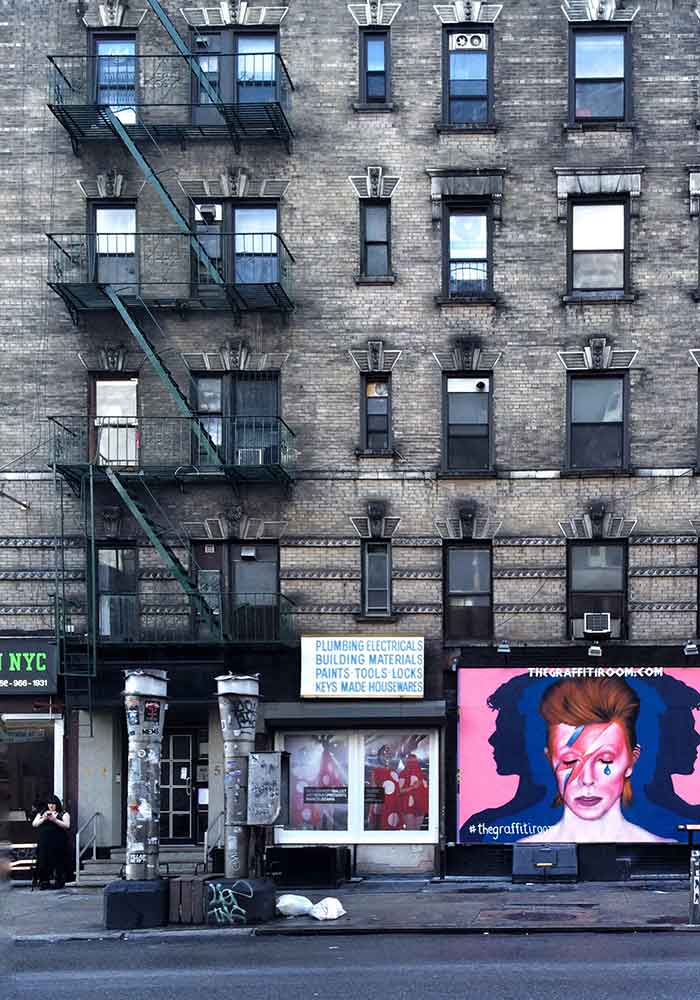
Bowie street art, New York
Essex House

Essex House, Manhattan
After spending much of the 1980s living in Switzerland, Bowie married the supermodel Iman in the early 1990s and moved to New York soon afterwards.
Settling in an apartment in the art deco landmark Essex House at 160 Central Park South, New York reinspired Bowie. Records like 1.Outside and Reality contained references to the city’s life, creative scene, and architecture and earned Bowie some of his best reviews in years.
The Essex House apartment recently went on sale, with an asking price of $6.5 million (although, as it comes with Bowie’s old grand piano, and amazing views of Central Park, that seems like a bit of a bargain).
Even if you can’t afford that, you can still get an experience of staying at Essex House, as the building is also home to the JW Marriott Essex House hotel.
Greenwich Village

Washington Square Park
Greenwich Village has shaped Bowie’s work in several ways. Its folk scene in the 1960s both inspired the young Bowie at the start of his career and was directly referenced in songs like Hunky Dory’s Song for Bob Dylan, and The Next Day’s (You Will) Set the World on Fire, which mentions the famous folk venues Gaslight and The Bitter End (which you can still find today at 147 Bleecker Street).
Bowie recorded the Young Americans album at Electric Lady Studios at 52 West Eighth Street. Founded by Jimi Hendrix, the studio is also still open today – recently hosting Lana Del Rey and Frank Ocean.
Greenwich Village is also home to Washington Square Park, which Bowie named his favourite place in the city.
Lafayette Street, Soho
After Essex House, Bowie and Iman moved to an apartment at 285 Lafayette Street, where he spent the rest of his life.
He was often spotted in the neighbourhood, record shopping on Bleecker Street or browsing the shelves at the Mcnally Jackson bookshop at 52 Prince Street.
The area also plays an earlier part in Bowie’s story. During the 1980s, he met Chic’s Nile Rodgers at the Continental – a bar well-known by musicians, and still in the same place by the Astor Place subway. The two went on to work together on several records, including Let’s Dance – which became Bowie’s best-selling album.
Galleries

The Metropolitan Museum of Art, New York
Bowie was a passionate art collector, and you can find some of the city’s best galleries within walking distance of his New York apartments. Lafayette Street is close to a number of private galleries, as well as the innovative New Gallery, which showcases upcoming talent. From Essex House, take a leisurely stroll through central park to some of the city’s most famous galleries, including the Guggenheim – with a world beating collection of modern art, with works by the likes of Andy Warhol, and The Metropolitan Museum of Art. Also known as the Met, the museum has one of the world’s greatest collections of art, including works by Tintoretto, one of Bowie’s favourite painters (he named his publishing company after the Italian old master).
Theatres
No visit to New York is complete without a trip to its world-famous Theater District, and two of the city’s theatres have a strong Bowie connection.
At the Booth Theater in 1980, Bowie took over the lead role in the hit production of The Elephant Man, and won rave reviews. In 2014, Bradley Cooper also took on the role on the Booth Theater’s stage.
The New York Theatre Workshop, at 79 East 4th Street, just around the Lafayette Street apartment, is where Bowie created one of his final works, the musical Lazarus, which premiered just a month before his death.
Where next?
Why stop there? Bowie was known for his love of traveling, with the subject inspiring several of his songs.
If you’re looking to extend your own Bowie tour, you could head to Blonay, Lausanne or Montreux in Switzerland, where Bowie lived and worked during the late 1970s and 80s, or the Caribbean island of Mustique, where he and Iman had a holiday home.
The V&A Museum’s hit David Bowie Is… exhibition also continues to travel the world, and can be seen at Barcelona’s Museu del Disseny from 25th May, and the Museo d’Arte Moderna di Bologna (MAMbo) in Italy, from 14th July – 13th November.

You can also win a night in London’s 5-star Athenaeum Hotel with our #MusicMakesYouTravel competition. Check out the details and enter here.
And for music-inspired guides to London, Berlin and New York (and beyond), check out our music site.
The post David Bowie’s London, Berlin and New York appeared first on lastminute.com Blog.
Source: lastminute.com

